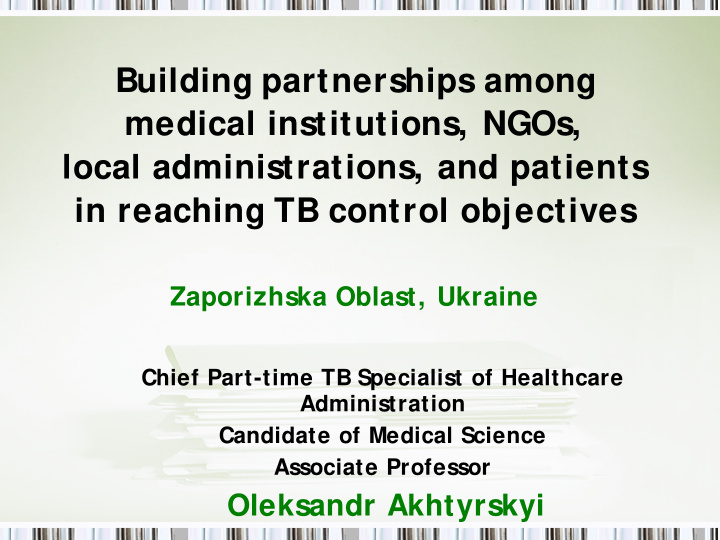



Building partnerships among medical institutions, NGOs, local administrations, and patients in reaching TB control objectives Zaporizhska Oblast, Ukraine Chief Part-time TB Specialist of Healthcare Administration Candidate of Medical Science Associate Professor Oleksandr Akhtyrskyi
UKRAINE • Zaporizhska Oblast is in southeast Ukraine. It is one of the leading industrial oblasts of Ukraine. • Consists of 24 administrative rayons (districts) • Population – 1 860 242 persons: 1 4141 813 reside in urban areas; 445 411 reside in rural areas. 2
Incidence of TB in Zaporizhska Oblast per 100 000 Population since 1990 92.5 100 89.8 91.3 90 84.5 80 79.8 65.3 84.1 70 60 Zaporizhska oblast 45.5 60.1 50 Ukraine 40 32 41.6 30 31.8 20 10 0 1990 1995 2000 2005 2006 2007 • Incidence increased 2.5 times over 17 years 3
TB Mortality per 100 000 Population since 1990 30 25.3 25 22.3 25.0 22.3 21.8 21.4 20 Zaporizhska Oblast 14.3 Ukraine 15 13.8 8.1 10 6.3 5 0 1990 год 1995 2000 2005 2007 • TB mortality increased 3.5 times over 17 years 4
Main Problems of TB Control in the Oblast • There are 115 TB specialists — 60% of total needed • TB patients: more than 54.2% are unemployed, but able to work; many of them have alcohol or drug problems and need support • High treatment default rate (30% in 2007) • Increasing number of drug resistant TB cases 5
Two Projects Were Initiated in Zaporizhska Oblast in February РАТН USAID funded WHO USAID funded Project Project «Support of «Strengthening TB case Ukraine National TB detection in general health Program» facilities according DOTS» Goal – technical assistance in implementation of effective TB control approaches based on WHO recommended strategy 6
ACSM Activities in Zaporizhska Oblast • Trainings on effective communication and counseling on TB and HIV/AIDS – led by PATH staff for 17 TB doctors and 18 TB nurses (counselors for the new counseling offices) • PATH-trained TB specialists conducted 16 trainings on effective communication for 246 TB doctors and nurses from 2006 to 2008 • Training for members of the Red Cross Society Oblast Committee on providing TB treatment support (24 participants) • Implementation of Red Cross and PATH collaborative project in TB treatment support • 3 counseling and patients’ psycho-social support offices established in TB facilities with PATH project support • Printed information TB materials and registration documentation for counseling offices 7
Much has already been accomplished in Zaporizhska Oblast: For the first time in Ukraine with the help of charitable funds, “Patriot of Zaporizhzhia”, “Unity for the Future”, and “White Chamomile,” rooms for TB patients to receive psycho-social support were established 8
Counseling and Psycho-social Support Offices • Veselyanka and 4 city TB dispensaries of Zaporizhzhia (#1,2,3 and 4) 9
Informational 2 offices working materials at the Oblast TB developed by dispensary PATH 10
Detection of HIV among TB patients in Zaporizhska Oblast for 10 months of 2008 • 2499 pre-test consultations were done by TB service specialists • 89% agreed to be tested • 66% were tested 11
Oblast Program Is Unique Incentive program to support initiation and completion of TB treatment This programs includes: Reimbursement of transportation costs to hospital for TB patients 12
There is also «Oblast program of social support to homeless and released prisoners with TB in 2006-2009» • 2007 — 793 persons • 2008 — 900 persons (3456 food-supply packages and 1728 hygienic packages) 13
DOT Management • 42 D ОТ offices in general medical facilities • From 2007, visiting nurses of the Oblast Red Cross Society in the frame of PATH TB project started help in DOT for “complicated” patients with high risk of treatment interruption and default • Social support (food and hygienic packages and transportation fees) for patients who observe treatment regiment 14
Key indicator for measuring ACSM program success is treatment default rate According to WHO recommendations, treatment default rate should be not more then 3% 2007 2008 Treatment interruption 30% 15% Treatment default 11% 2,4% 15
TB in Zaporizhska Oblast is Stabilizing • Decrease in TB incidence • Decrease in destructive and neglected forms of pulmonary TB • Decrease in TB incidence among children • Decrease in treatment interruption • Improved effectiveness of sputum microscopy in detecting TB at general medical facilities 16
17
Recommend
More recommend